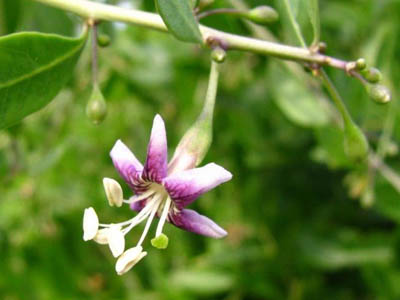Lycium barbarum
1. Lycium barbarum L. (syn.: L. halimifolium Mill.) (China) – Much cultivated as an ornamental shrub (mostly for hedging or erosion control) in private and public gardens, along railway tracks, motorways,… Formerly introduced on purpose in coastal dunes (sand binder, erosion control). First recorded as an escape from cultivation in 1857 near Tienen. However, most records are probably mere relics of cultivation. Rather rarely (if ever?) found self-sown. At present Lycium barbarum is widely naturalised in coastal dunes. In inland locations it is much rarer but naturalised populations have been reported from urban habitats in Brussel and in the valleys of river Meuse and Sambre (Van Landuyt 2006). Lycium barbarum usually grows on dry, sun-exposed calcareous soils.
Lycium barbarum is very similar to L. chinense and much confused. Both are sometimes even considered to be conspecific (Clement & Foster 1994, Adolphi 1995). However, recent Chinese taxonomists clearly accept both species (see for instance Zhi-Yun & al 1994). Belgian collections of Lycium barbarum always have narrow leaves (more than three times as long as wide) that are acute at apex and taper at both ends. In Lycium chinense leaves are much wider (less than three times as long as broad), widest below middle and acute at apex. In both species corolla lobes are ciliate at margins (contrary to Zhi-Yun & al 1994) but in Lycium barbarum often less obviously so. When reflexed corolla lobes of Lycium chinense slightly reach beyond the base of the calyx whereas in L. barbarum they do not reach the base of the calyx.
|
|
 |
Selected literature:
Adolphi K. (1995) Neophytische Kultur- und Anbaupflanzen als Kulturflüchtlinge des Rheinlandes. Nardus 2: 272 p.
Clement E.J. & Foster M.C. (1994) Alien plants of the British Isles. BSBI, London: XVIII + 590 p.
Schmid M. (2005) Untersuchung zur neophytischen Gehölzflora im Stuttgarter Stadtgebiet. Jh. Ges. Naturkde. Württemberg 161: 178-257.
Van Landuyt W. (2006) Lycium barbarum. In: Van Landuyt W., Hoste I., Vanhecke L., Van den Bremt P., Vercruysse W. & De Beer D., Atlas van de flora van Vlaanderen en het Brussels gewest. Instituut voor Natuur- en Bosonderzoek, Nationale Plantentuin van België en Flo.Wer: 564.
Zhi-Yun, Z., An-Ming, L. & D,Arcy, W.G. (1994) Lycium. In Raven, P. H and Wu, Z. Y. (eds.) Flora of China. 17. -Science Press, Beijing and Missouri Botanical Garden: 301-304.


